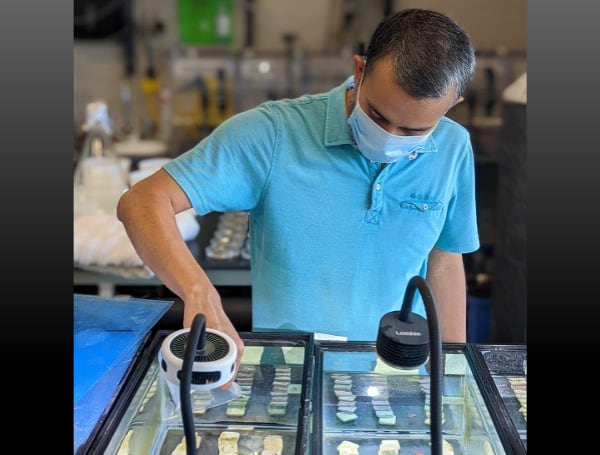
Coral reef ecosystems are severely threatened by pollution, disease, overharvesting and other factors. For thousands of years, long-spined sea urchins helped keep reefs intact.
They eat seaweed, which can kill or seriously damage coral. Without coral, reefs suffer severe consequences, including diminished ability to support fish.
In the mid-1980s, more than 90% of the urchins that crawled the coral reefs in the western Atlantic and Caribbean died for reasons scientists have yet to determine. The population of the long-spined sea urchin – known scientifically as Diadema antillarum — has been slow to recover on its own. That’s why scientists, including Josh Patterson, are stepping up their efforts to enhance urchin populations.
“You could call these urchins the lawn mowers of the reefs,” said Patterson, a UF/IFAS associate professor of fisheries and aquatic sciences. “They eat fleshy seaweeds that grow out of control on coral reefs and ultimately smother the corals.”
The UF/IFAS restoration ecologist is trying to return more of the urchin to an area that roughly includes the seas off the Florida Keys, Bermuda, the Yucatan Peninsula, Aruba and the Virgin Islands. He’s taken a small step toward the overarching goal of revitalizing the population of the vital echinoderm.
Patterson used about 200 urchins for his latest experiment – an amazingly high number, considering how difficult they are to grow. “You could collect 200 wild urchins without too much trouble; growing 200 of them via aquaculture is much more difficult,” he said.
In the study, he and his colleagues showed that by feeding dried seaweed to baby cultured long-spined urchins, they can help them grow faster and behave more like natural urchins than if you give them commercial pellets that are normally fed to herbivorous fish in marine aquariums.
“If the urchins behave naturally, they’re more likely to find shelter on the reef and survive to consume the seaweed,” Patterson said
As for that natural behavior, long-spined sea urchins are nocturnal. For the experiment, scientists came in every six hours – at midnight, 6 a.m., noon and 6 p.m. — and recorded the proportion of urchins in each tank that were actively eating, foraging or hiding. The ones fed dried seaweed were more likely to be eating at 6 a.m., a time you would expect them to dine.
The trick now is: Will the urchins multiply on the coral reefs?
“The ultimate idea is to try and grow thousands and thousands of urchins to restock the reef so they will eat the seaweed overgrowth,” said Patterson, a faculty member at the UF/IFAS Tropical Aquaculture Lab. “These findings are steps toward that ultimate idea. And you want to be able to produce them faster.”
For this study, Patterson worked with six fellow scientists, including Lotus Hassan, a post-doctoral research associate in the UF/IFAS School of Forest, Fisheries, and Geomatics Sciences. Patterson and his colleagues conducted the experiment at the Florida Aquarium’s Center for Conservation in Apollo Beach, where Patterson works. This experiment and many others he conducts would only be possible with the collaboration he enjoys with the Florida Aquarium.
Visit Tampafp.com for Politics, Tampa Area Local News, Sports, and National Headlines. Support journalism by clicking here to our GiveSendGo or sign up for our free newsletter by clicking here.
Android Users, Click Here To Download The Free Press App And Never Miss A Story. Follow Us On Facebook Here Or Twitter Here.
Copyright 2022 The Free Press, LLC, tampafp.com. All rights reserved. This material may not be published, broadcast, rewritten, or redistributed.

